The national flag of the Republic of Mauritius is a vibrant and deeply symbolic emblem, encapsulating the island nation's journey from colonial rule to a thriving independent state. Adopted on March 12, 1968, the day Mauritius gained independence from the United Kingdom, the flag's design is a powerful visual narrative of its history, diverse population, and aspirations for peace and prosperity. It stands as a proud testament to the resilience, unity, and forward-looking spirit of the Mauritian people.
Design and Symbolism: A Spectrum of Aspirations and Heritage
The flag of Mauritius is a simple yet profoundly meaningful four-colored horizontal striped banner. Each of the four equally wide horizontal stripes bears a distinct color, meticulously chosen to represent key aspects of Mauritian identity and history:
-
Red (Top Stripe): The uppermost red stripe symbolizes the blood shed in the struggle for independence and the nation's determination to achieve freedom. It represents the sacrifices made by the Mauritian people in their pursuit of self-determination and their unwavering courage in the face of colonial oppression. Red also signifies the dawn of a new era, marked by sovereignty and self-governance.
-
Blue (Second Stripe from Top): The blue stripe beneath the red represents the Indian Ocean, which surrounds the island nation. It reflects Mauritius's unique geographical position as an island paradise and its deep connection to the vast expanse of water that has shaped its history and economy. Blue also signifies the peaceful pursuit of a brighter future and the tranquility that characterizes the island's natural environment.
-
Yellow (Third Stripe from Top): The yellow stripe, positioned below the blue, symbolizes the light of independence shining over the island and the nation's bright future. It represents prosperity, wealth, and the optimism of a young nation striving for economic growth and social progress. Yellow also subtly acknowledges the significant Indian diaspora, as it is a color of importance in some Indian cultural contexts, reflecting the multi-ethnic fabric of Mauritian society.
-
Green (Bottom Stripe): The lowermost green stripe represents the lush vegetation and agriculture of Mauritius, which are vital to its economy. It signifies the island's rich natural resources, its fertile land, and the vibrancy of its natural environment. Green also embodies the hope for a prosperous future through sustainable development and the continued growth of its agricultural and ecological sectors.
The combined effect of these four colors creates a vivid and harmonious composition, reflecting the nation's diverse heritage and its collective aspirations.
Dimensions and Proportions:
The official proportions of the Flag of Mauritius are a width-to-length ratio of 2:3. This standard ratio ensures a balanced and aesthetically pleasing appearance. The four horizontal stripes are of equal width, ensuring that each symbolic color is given equal prominence on the national flag. This meticulous proportioning underscores the equal importance of each represented aspect of Mauritian identity and history.
History and Evolution: From Colonial Ensign to National Symbol
The history of the Mauritian flag is directly linked to its colonial past and its hard-won journey to independence.
-
Pre-Independence (British Colonial Rule): For over a century and a half, Mauritius was a British colony. During this period, the official flag was the British Blue Ensign, defaced with the colonial badge of Mauritius. This badge typically featured a dodo and a ship, symbolizing the island's unique fauna and its maritime history, respectively. While serving as the colonial standard, this flag did not represent the emerging national identity or the aspirations for self-rule.
-
Path to Independence and Flag Adoption (1968): As Mauritius prepared for independence, there was a clear need for a new national symbol that would reflect its unique character and its newfound sovereignty. A design competition was held, and the winning design, featuring the four horizontal stripes, was created by Heraldist Jean Napal. The flag was formally adopted on March 12, 1968, the very day Mauritius became an independent sovereign state within the Commonwealth. The choice of colors was deliberate, intended to encompass the island's historical struggles, its natural beauty, its diverse population, and its hopes for the future.
-
Republic Status (1992): When Mauritius transitioned from a Commonwealth Realm to a Republic on March 12, 1992, the national flag remained unchanged. This continuity underscored the enduring significance and broad acceptance of the flag's design as a symbol of the Mauritian nation, regardless of its constitutional status.
The flag has remained a constant and unifying symbol throughout Mauritius's post-independence history, representing the continuity of its national identity and values.
Regional Context and Island Nation Identity:
Mauritius is an island nation located in the Indian Ocean, east of Madagascar and northeast of Réunion. Its flag, with its simple yet powerful horizontal striped design, stands out in the regional context. While many African nations adopted Pan-African colors (red, yellow, green) after independence, Mauritius's unique combination of red, blue, yellow, and green sets it apart.
The blue stripe distinctly references the Indian Ocean, emphasizing Mauritius's identity as a small island developing state (SIDS) heavily reliant on its marine environment and maritime connections. Unlike landlocked African nations or those with extensive continental borders, Mauritius's existence is intrinsically linked to the ocean. The vibrant colors also reflect the island's tropical climate, its rich biodiversity, and its reputation as a multicultural hub. This distinct flag design reinforces Mauritius's unique position as a multicultural, democratic, and economically progressive island nation in the Indian Ocean.
Interesting Facts:
-
Designed by a Local Heraldist: The flag was designed by Jean Napal, a Mauritian heraldist, ensuring its deep connection to the island's identity.
-
Independence Day Adoption: The flag was adopted on the very day of independence, March 12, 1968, making it intrinsically linked to the nation's birth.
-
Four Equal Stripes: The four equally wide stripes symbolize the equal importance of the elements they represent: sacrifice, ocean, prosperity, and nature.
-
No Coat of Arms: Unlike many former British colonies whose flags incorporate a coat of arms, Mauritius's flag is a pure horizontal tricolor (or rather, quadricolor), simplifying its design and emphasizing its abstract symbolism.
-
"Four-Banded" Flag: It is often colloquially referred to as the "Four-Banded Flag" due to its distinctive design.
-
Symbol of Multiculturalism: While not explicitly representing specific ethnic groups, the collective symbolism of the colors is inclusive, reflecting the multicultural harmony of the Mauritian population.
-
Stability of Design: Despite political changes and the transition to a republic, the flag's design has remained unchanged, demonstrating its enduring acceptance and national significance.
-
Tourism Appeal: The vibrant colors also visually appeal and are often associated with the island's reputation as a beautiful tropical tourist destination.
-
Maritime Nation: The blue stripe specifically highlights Mauritius's crucial identity as a maritime nation, reliant on its ocean resources.
Significance for the Inhabitants: A Banner of Unity, Progress, and Identity
For the people of Mauritius, their national flag is more than just a piece of fabric; it is a profound emblem of their collective identity, their shared history, and their aspirations for a prosperous and harmonious future. It embodies the essence of what it means to be Mauritian.
The red stripe serves as a poignant reminder of the sacrifices and struggles endured to achieve independence. It instills a sense of patriotism and gratitude towards those who paved the way for self-governance. This color evokes the courage and determination that define their historical journey.
The blue stripe speaks to their unique geographical reality as an island nation. It symbolizes the vast Indian Ocean that surrounds them, a source of livelihood, natural beauty, and a link to the wider world. It fosters an appreciation for their natural environment and a sense of peaceful coexistence within it.
The yellow stripe represents the bright future they collectively envision – one filled with prosperity, development, and the continued illumination of knowledge. It instills optimism and encourages diligence in building a thriving nation. This color also subtly acknowledges the various cultures that have contributed to Mauritius's richness, bringing light and vibrancy.
The green stripe connects them to their fertile land, their agricultural heritage, and the abundant natural beauty of their island. It symbolizes hope for sustainable growth and a healthy environment for generations to come. This promotes a sense of stewardship over their unique ecosystems.
Together, these four colors form a tapestry of national unity, representing the diverse ethnic, cultural, and religious groups that coexist peacefully on the island. The flag is displayed with immense pride during national celebrations, at schools, and in daily life, serving as a constant reminder of their shared heritage, their resilience in the face of adversity, and their collective commitment to building a cohesive and prosperous society. It is a cherished symbol that binds Mauritians together, inspiring them to continue striving for progress while cherishing their unique identity as a rainbow nation.
In the demonstration images, full-size flags are shown with proportions of 2:3, and hand-held flags with proportions of 1:2.
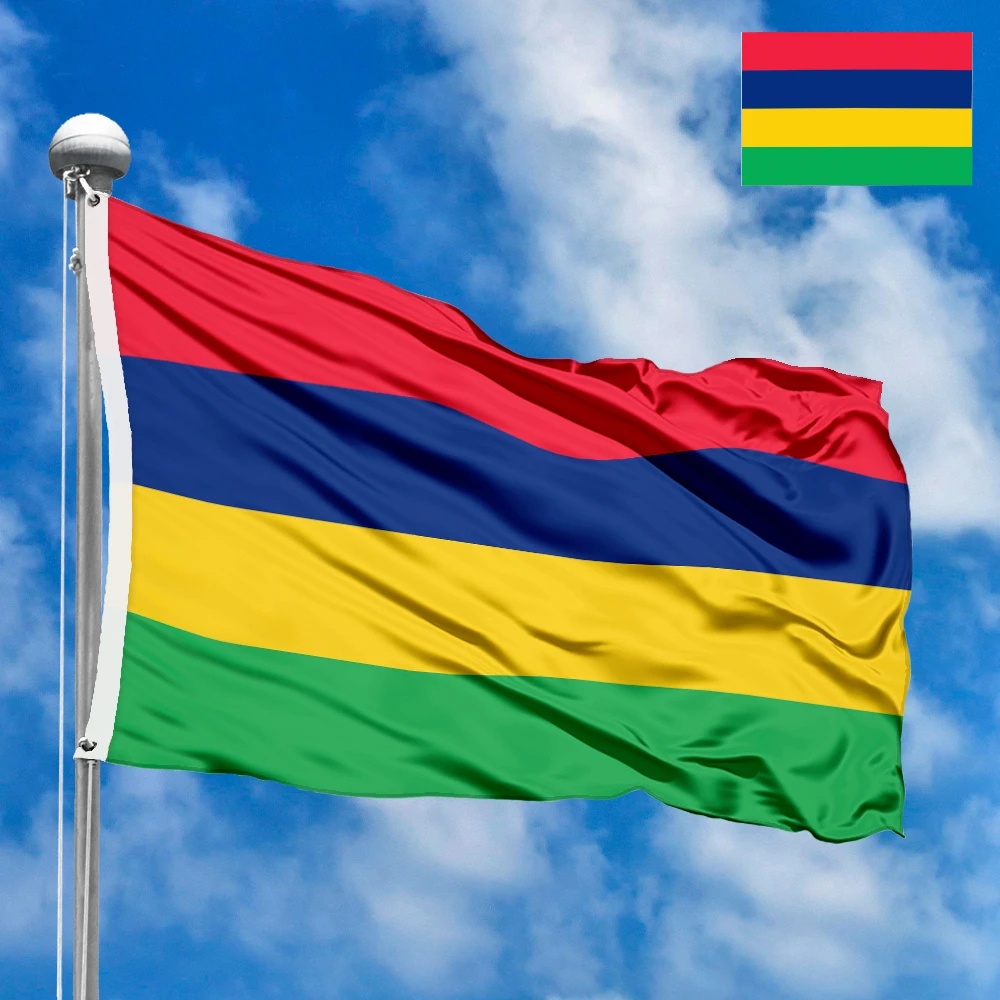

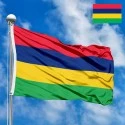
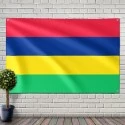
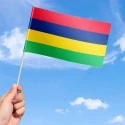

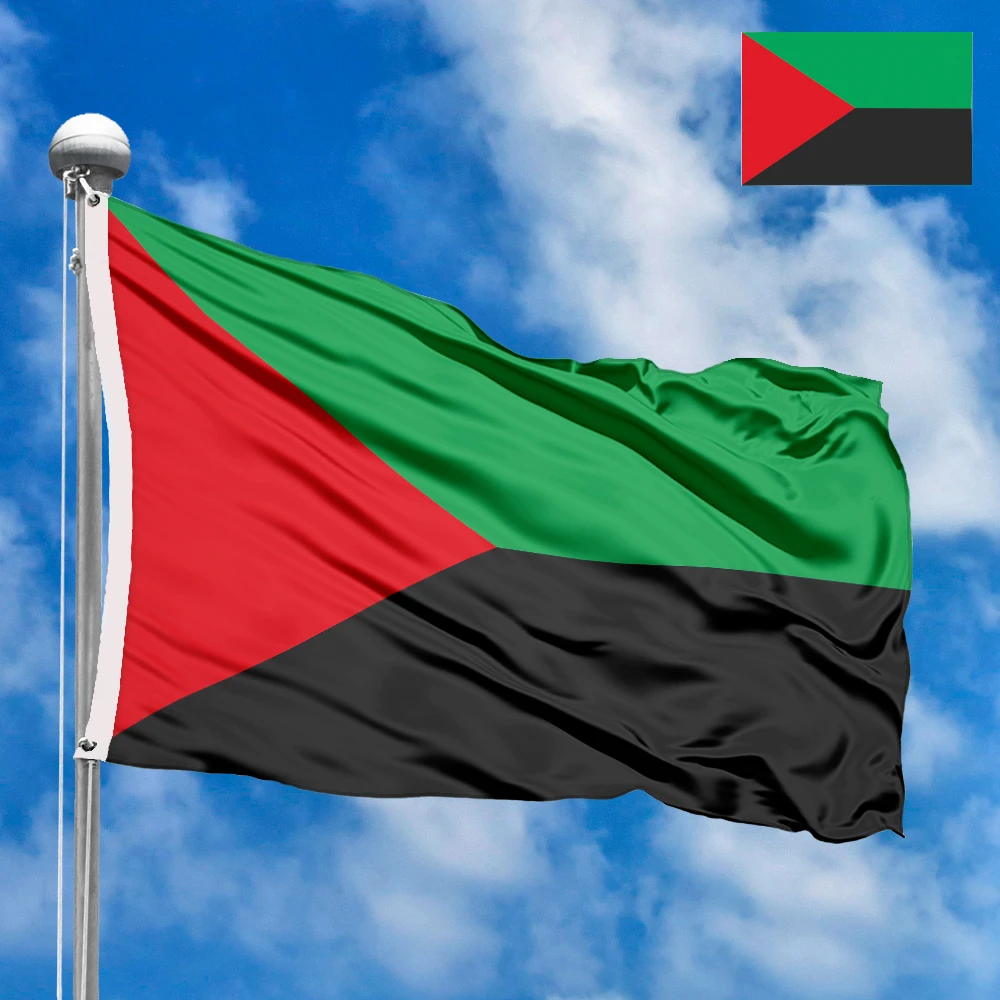

 Waving flag
Waving flag
 Sizes:
Sizes:
 Round flag
Round flag
 Sizes:
Sizes:
 Rectangular flag 2:3
Rectangular flag 2:3
 Sizes:
Sizes: